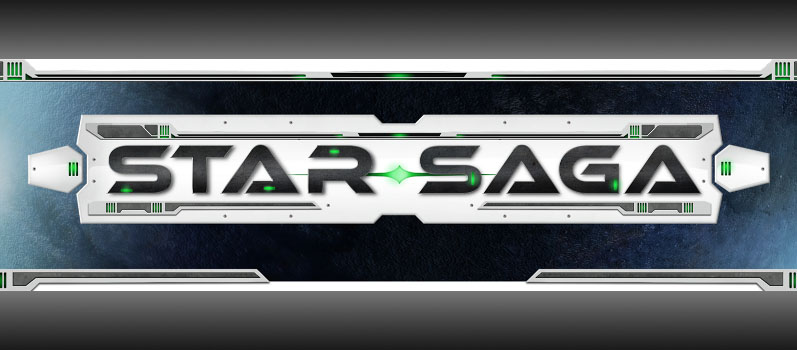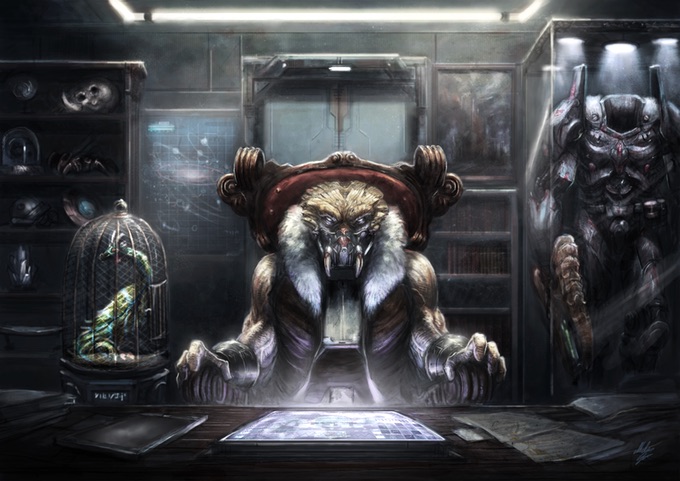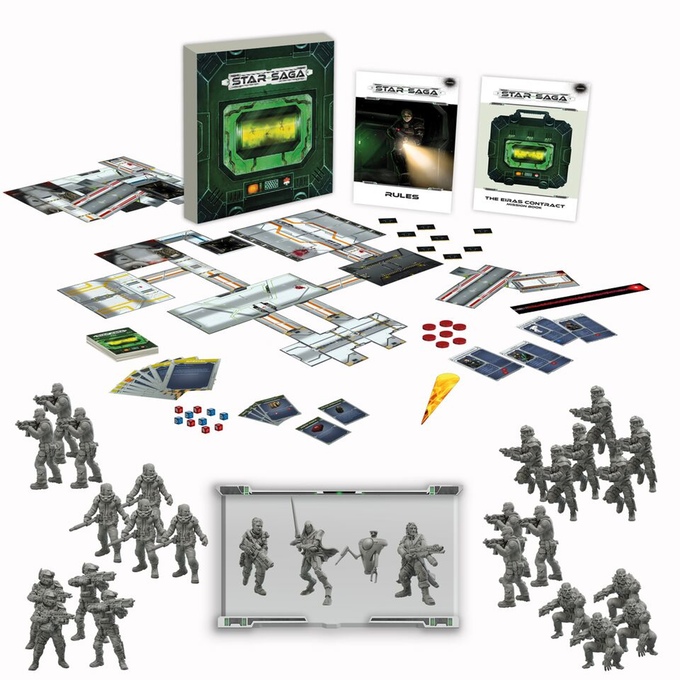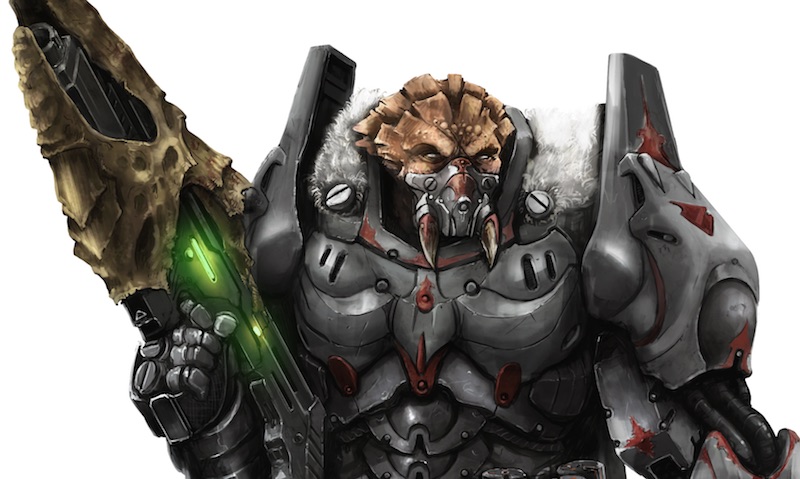Mantic’s Star Saga: Interview
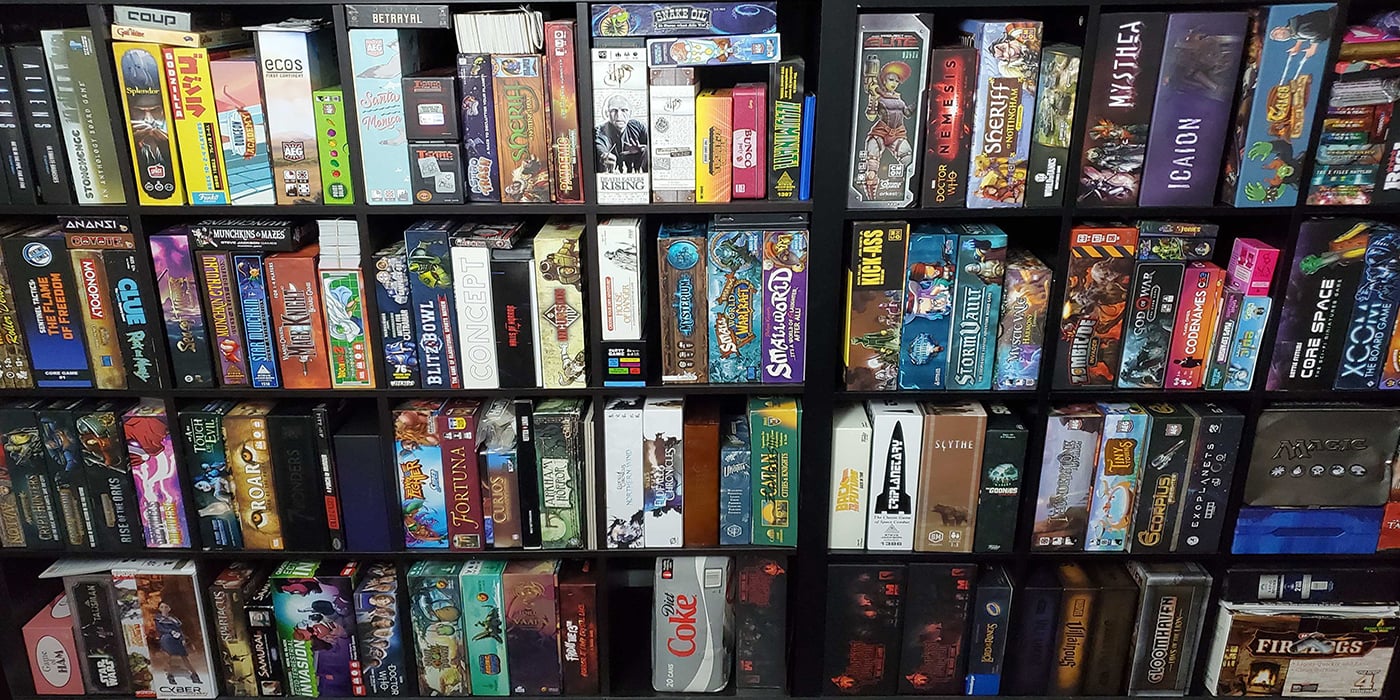

We got a chance to sit down with Mantic’s Adam Levine who gave us the scoop on the upcoming game.
What exactly is Star Saga–is this a new IP for Mantic? Tell us a little bit about the story.
Star Saga is a new IP in the sense that we’ve created a new set of protagonists and a new story that we’d like to see continue. That said, as you can probably see, the entire narrative and all of the characters are firmly set within our pre-established Warpath Universe.
In Star Saga, the bounty hunter known as Blaine—who appears in virtually every game Mantic has ever published (and is sort of a company mascot at this point)—has been hired to retrieve some tech stolen from a major corporation, and to do so must hire a cadre of the galaxy’s top mercenaries.
That’s the real impetus for the story, but once the mercs infiltrate the enemy base, players will be taken through a story with many twists and turns that will keep them engaged as they play. The baddies they face will reveal new story elements that point to a larger conspiracy within the facility, and the mercenaries will suddenly have multiple objectives, and have to decide together as a team which ones are more important to pursue as the game progresses.
The press release mentioned that this is part of a series of dungeon crawlers, with Dungeon Saga being the first. How similar is Star Saga to that game, and will all games in the series follow the same format?
Well it’s about more than just a dungeon crawler—it’s a specific type of character and story-driven dungeon crawler that we’re talking about– i.e. a group of named characters pitted against an ‘overlord’ villain. We feel it’s an underdeveloped game style, because it’s only ever done in fantasy really. And there’s a lot of room to explore different settings and genres—for example there really aren’t many sci-fi games in this style, so maybe there are other genres we could play with. How would a zombie apocalypse run like this work? How about a Wild West setting, or a superhero story?
Each genre will present its own opportunities not just with visuals and characters but in its rules. In Star Saga, for example, there is obviously much more ranged combat than you’d find in a fantasy dungeon crawler. Characters in a superhero crawler might fly, and a Wild West crawler might include horses and duels. These are just examples off the top of my head, but as you can see, each of these presents opportunity for different rules and mechanics, and very different kinds of narrative scenarios to make each game a truly unique experience.
At the same time they will all likely utilize the same underlying mechanics that have made Dungeon Saga so popular.
After the success of Dungeon Saga, why Kickstart Space Saga rather than a standard retail release?
Crowd funding allows us to make the game bigger and better based on how much support we receive. Dungeon Saga raised over $1M, and with that we were able to add more sculpts, more scenarios and more components, as well as 4 expansions that we more than likely wouldn’t have gambled on if we’d just used a more standard retail model, so we’re hoping we can have similar success with Star Saga.
But we’ve never abandoned our retailers; our Walking Dead: All Out War miniatures game features several expansions available only in stores, and of course our core games like Kings of War, Dungeon Saga, and Deadzone continue to sell in stores long after their campaigns and in much higher numbers. So with this crowd-funding we’re able create better games that retailers can sell for years to come.
How hard is it to come up with characters and scenarios for a game like Star Saga?
Everyone has their pre-conceived ideas of what a sci-fi story should include, and the trick for us is finding something that’s familiar, but also puts an interesting and hopefully new twist on it. Mixing a popular race with an unconventional character class for example, or adding a cool reveal to a scenario objective so it is isn’t the obvious thing the players were expecting. We never want our games to feel like it’s just another in a long line of games, and so it’s both challenging and a lot of fun.
And of course the beauty of a science fiction setting is that the limits are only that of the imagination (as Rod Serling would say).
Typically there haven’t been many science fiction themed dungeon crawlers – why did you want to make the theme more futuristic and what are the difficulties associated with that?
It’s precisely because there haven’t been many in the sci-fi genre that prompted us to pursue it. After the success of Dungeon Saga, we felt that we had something really special, and the first thing that popped into our heads was, essentially, “Dungeon Saga in Space” as a follow-up. Sci-Fi and Fantasy are the two biggest genres in tabletop gaming, so it seemed like a natural route to take.
The difficulty came with taking a gaming style that is typically fantasy-based, and making it ‘feel’ sci-fi. The dungeon crawler staples of swords, sorcery and treasure don’t really apply to the sci-fi setting, but if we removed them it would take a lot away from what makes dungeon crawlers so much fun. We’ve had to look at ways to translate many of the popular dungeon crawler elements into this setting while still making it feel authentic – moving the focus from close combat to shooting, swapping spell-books for technological ‘wizardry’ and replacing treasure chests with ammo crates, for example. Furthermore, sci-fi games tend to be faster paced and fluid, so it’s been important to streamline the game mechanics at the same time. It’s definitely been a challenging balancing act, but the result is a fantastic blend of the sci-fi setting and game style.
During a Kickstarter, how important is it to listen to the community and can their comments during the campaign influence the finished product?
As with any business, listening to your community is always important, but doubly so with a kickstarter, because its these fans that are making everything possible. As a project creator in the tabletop gaming space, our campaigns have, by-and-large, one of the higher rates of comments, and while it’s always a challenge to respond to every question, comment, and suggestion, we feel we are one of the best at engaging with our fans. We really do take the time to read their comments, and listen to their ideas and their criticisms. We won’t always get it right, but we always do our best to hear to what they have to say, and respond in a way that will make them happy. End of the day we want our fans not just buying our games, but playing them and enjoying them with their friends the same way we do. We’re all fans and gamers here, too!
How much playtesting goes into a project like this?
We always do a healthy amount of play testing, and with Star Saga it’s been no different—in fact it has been one of our more intensely tested games. We really want this to be a game that is quick and easy to pick up and play, and where every scenario feels right and well-crafted. We’ve held open gaming days at Mantic HQ in Nottingham, UK and allowed fans to come in and test it with us and offer suggestions, comments and criticisms. We hold twice weekly play sessions in the office, and will continue to do so until we get it just right. We monitor fan feedback online and always consider what they have to say when testing out the game. We’ve also released the first alpha rules online for download and public playtest so fans can see it for themselves, play it with proxy figures and cards, which has already provided us with some great feedback on both the rules and presentation.
Thanks so much for talking with us!

